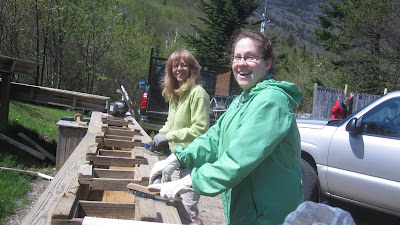The Michael and Claudia Yatsevitch Forest in Cornish and Plainfield is unique in that it has the greatest plant diversity of any Forest Society reservation. The reason for this lies in the rich soils of the Connecticut River valley - moist soils rich in mineral nutrients and organic matter that support a great variety of plants, particularly herbaceous plants on the forest floor. There are many unique types of plants that are found in this
Rich Mesic Forest natural community, but unfortunately invasive exotic weeds also grow here perfectly well too! In order to protect this exceptional example of a Rich Mesic Forest, the Forest Society has been battling non-native invasive plants on the Yatsevitch Forest for a many years now, using both professional labor and volunteer/staff efforts.
 |
| Volunteers tackling a large forest of Common Buckthorn |
On a recent workday, a group of 12 volunteers and Forest Society staff met to tackle a large concentration of Common and Glossy Buckthorn shrubs (
Rhamnus, spp) that were identified on the property. Buckthorn was introduced to the United States in the 1800s, probably as an ornamental shrub, but it quickly expanded beyond the bounds of residential gardens and invaded other habitats. Like many invasive plants, buckthorn is a generalist, meaning it wills survive (and thrive!) in a variety of different soil types, moisture conditions, and light levels. It spreads by seed, eaten and dispersed by birds and small mammals, and can rapidly spread in a forest habitat once plants have reached fruiting maturity. On the Yatsevitch Forest, a large and very established area of Common Buckthorn shrubs (really small trees, many almost 25' tall!) were waiting to be dispatched by volunteers. Most of the plants were so large that we decided to girdle them (cut through the bark all the way around the tree) as a means of treatment. Smaller plants were cut or hand-pulled. Forest Society staff and land stewards will be back to check on this area in the Fall and early Spring next year. If significant stump sprouting occurs, we'll have to treat that as well. As with most invasive species treatment, keeping the threat of invasive plants at bay on the Yatsevitch Forest will be an ongoing battle, and one that I know we will need land steward help with for many years to come!
 |
| Land Steward Bob Lyon (Foss Forest, Gilmanton) girdles a large buckthorn. |
 |
| Girdling process- two cuts through the bark cambium, all the way around the tree |
 |
| Wendy did get to cut a few trees down :) |











